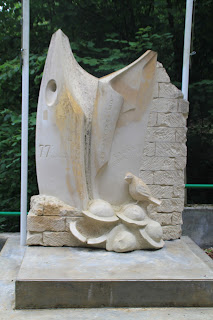Hotel
St. Paul
Verdun,
FranceAugust 20, 2015
The
weather was warmer today as we headed by bus nearby to explore the
beginning of the Meuse-Argonne Sector, a 25 mile front. It is the
largest battle in American history, over difficult terrain—with
ridges, the Meuse River, the Argonne Forest, the Aire River, and the
Moselle River. Fought between September 26 to November 11, 1918, this
battle involved 1.2 million soldiers. Six hundred thousand American soldiers were involved in the opening attack.
While
driving, we reviewed maps of the first assaults. We are only about 40
miles from Germany and the area was especially important to the
Germans. First we stopped at a well known monument near Chattancourt,
Le Mort Homme area dedicated to the 69th French
Division—the monument depicts an enrobed skeleton holding a flag
staff. The inscription, “Ils n'ont pas passe,” meaning they did
not pass. The French were determined to take this hill. It is said
that this is a woods where birds never sing. Losses were heavy but
Verdun was saved. The area was reforested because nothing else would
grow there. [Note: We try mostly to stay in the same time period as
we examine battle areas, but Le Mort Homme was 1916]
Back to
the 1918 period, we stopped at a large American monument near
Malancourt, where 600,000 soldiers were involved in the opening
attack of the Meuse Argonne offensive. There were two hundred steps
to the top, but I was more interested in the German observation post
and trenches. An Abbe in ruins from the shelling was behind the
monument, left as is.
Other
areas we visited:
- The site of the Lost Battalion incident (77th Liberty Division from New York)
- A monument to Cher Ami, a carrier pigeon that was wounded but still carried a message out about where the lost battalion was
- Pennsylvania monuments---the state of Pennsylvania had more burials in France from the war than any other state. Three monuments, one especially large (2 acres, both sides of the street in Varenne), were erected by Pennsylvania. (3 PA divisions: 28th, 78th, 79th)
- Exermont near where Larry's father's 1st Division, 18th Regiment was.
- Sergeant York Memorial and the path where he encountered Germans who surrendered to him (he was a Corporal at the time) (Chatel-Chehery (CMOH)
- Flaysville/Clierges (check) where our Uncle Earl's 37th Engineers Division specialized in electrical work.
- Sam Woodfill (CMOH)
I noted the ferns growing along side the road in the forest
areas—they made me think again of the dried fern that Archie either
carried home or sent home. The fern. Did it distract him from the
horrors all around him? Was it a connection to home? A
distraction? Why? A fern, the feathery leaves, the bright green, long
since faded. Was it the rare vegetation you saw amongst the
devastated ruined landscape? Why?




No comments:
Post a Comment